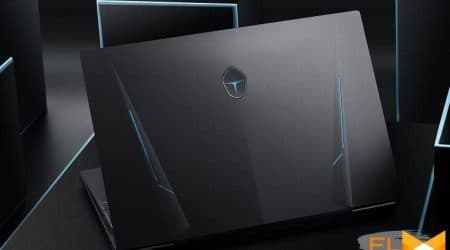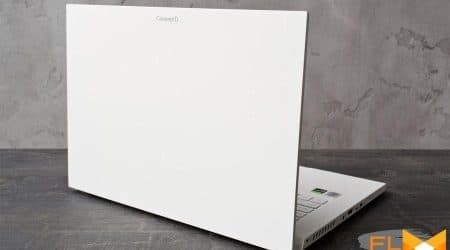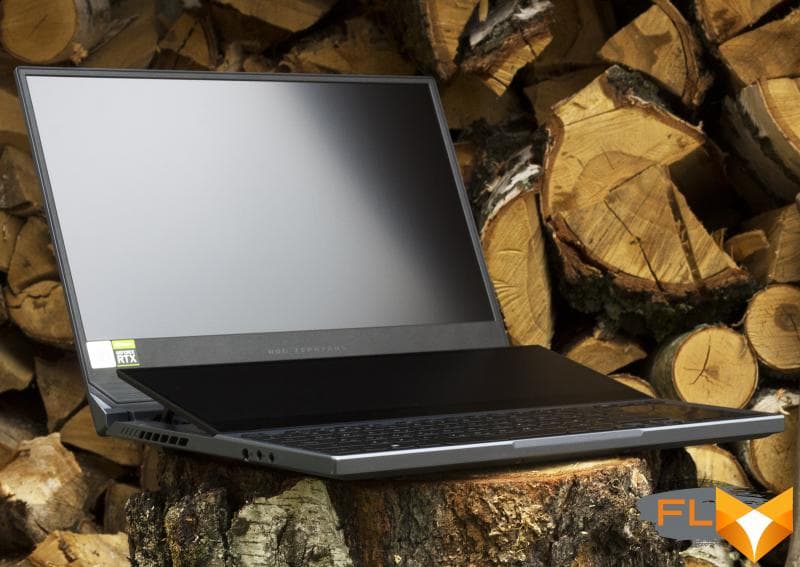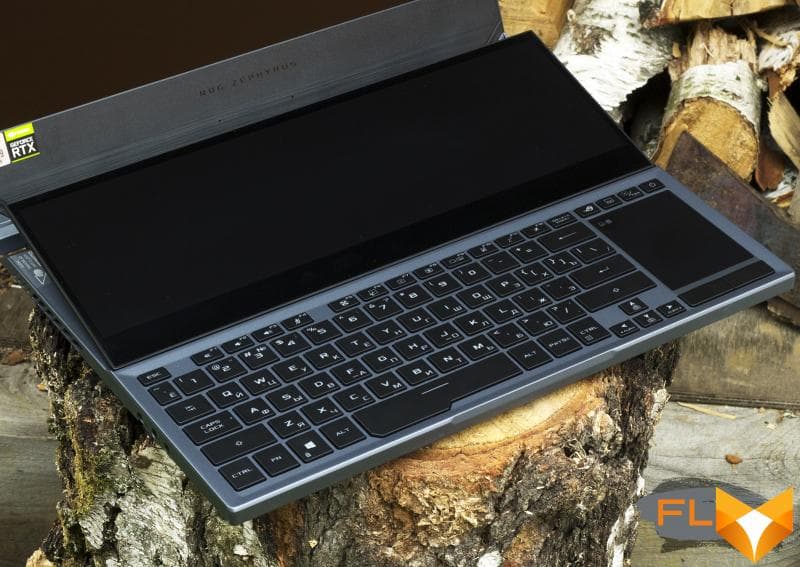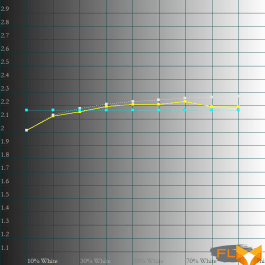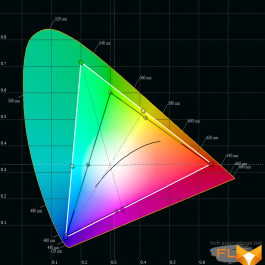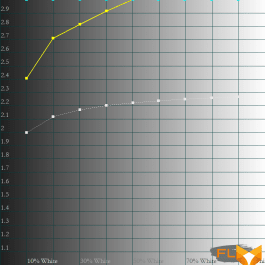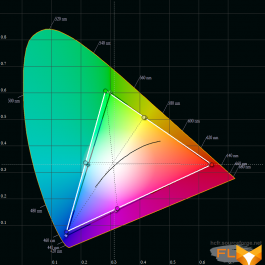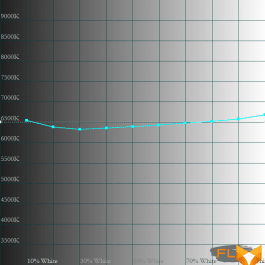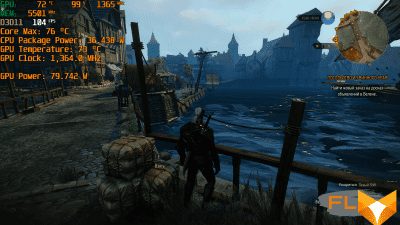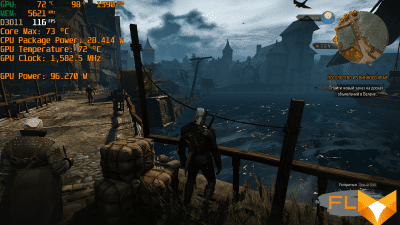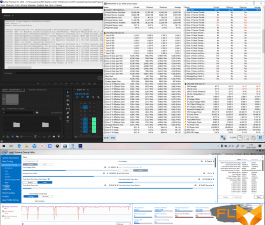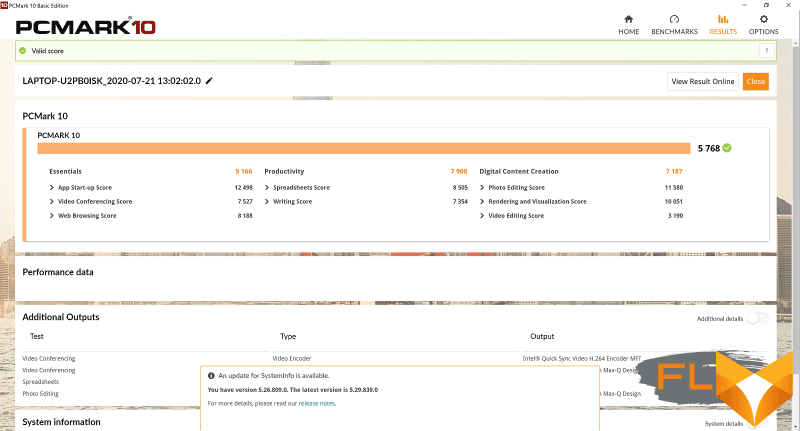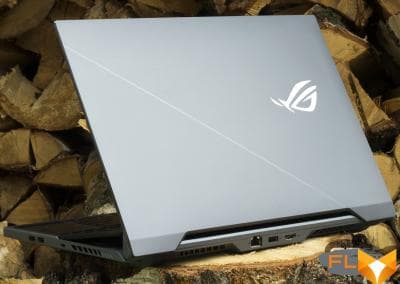


The new ROG Zephyrus Duo 15 is conceptually very similar to the ZenBook Pro Duo UX581GV we wrote about last year. Unlike other manufacturers, ASUS engineers have implemented a full-fledged additional 14-inch screen with a resolution of 3840 × 1100 pixels into the design of both laptops – Zephyrus calls it ROG ScreenPad Plus. At the same time, the size and weight of the laptop practically did not suffer – in front of you is a rather compact, but very quick “tag”. Yet the ROG Zephyrus Duo 15 is not a copy of the ZenBook Pro Duo UX581GV. This is a new and improved version – a kind of evolution of ASUS dual-display laptops.
ASUS ROG Zephyrus Duo 15
⇡#Specifications, equipment and software
On sale you will find several modifications of the ROG Zephyrus Duo 15. The GX550LXS version uses the GeForce RTX 2080 SUPER mobile graphics, and the GX550LWS uses the GeForce RTX 2070 SUPER, and only in conjunction with an 8-core Core i7-10875H processor. After examining the table, you will understand that all ROG Zephyrus Duo 15 configurations are as pumped as possible – so much so that the manufacturer did not even consider installing a 6-core Comet Lake option. On the other hand, the GeForce RTX 2080 SUPER is implemented in Max-Q design, which means that the GPU runs at a lower frequency. However, we will consider in detail the gaming (and not only) capabilities of the hero of today’s review.
| ASUS ROG Zephyrus Duo 15 | |
| Primary Display | 15.6″, 1920×1080, IPS, 300Hz, 3ms, 100% sRGB 15.6″, 3840 × 2160, IPS, 60Hz, 100% AdobeRGB |
| Additional display | 14″, 3840 × 1100 IPS 60Hz 72% NTSC Touch |
| CPU | Intel Core i9-10980HK Intel Core i7-10875H |
| Video card | NVIDIA GeForce RTX 2070 SUPER 8GB GDDR6 NVIDIA GeForce RTX 2080 SUPER 8GB GDDR6 |
| RAM | Up to 48GB DDR4-3200 |
| Install Drives | 2 × M.2 in PCI Express x4 3.0 mode |
| Optical Drive | None |
| Interfaces | 2 × USB 3.2 Gen1 Type-A 1 x USB 3.2 Gen2 Type-C 1 x USB 3.2 Gen2 Type-A 2 × 3.5 mm mini-jack 1 x RJ-45 1 x HDMI |
| Built-in battery | 90 Wh |
| External power supply | 240W and 65W |
| Dimensions | 360 × 268 × 20 mm |
| Notebook weight | 2.40kg |
| Operating system | Windows 10 Home Windows 10 Pro |
| Warranty | 2 years |
| Price according to ASUS | From $4,000 |

Perhaps the coolest version of the ROG Zephyrus Duo 15 arrived, in which, in addition to the Core i9-10980HK and GeForce RTX 2080 SUPER, 32 GB of DDR4-3200 RAM and two terabyte SSDs combined in a RAID 0 array were installed. GB of RAM is already soldered on the motherboard – as a result, the maximum amount of Zephyr RAM can reach as much as 48 GB, that is, the laptop can be oriented to perform serious computational tasks.
The official ASUS store previously sold the GX550LXS-HC066T test configuration for $5,300. In addition, according to ASUS, the GX550LWS-HF109T (IPS 300Hz, Core i7, 16GB RAM, 1TB SSD, RTX 2070 SUPER) will cost $4,000, while the GX550LXS-HF150T (IPS 300Hz, Core i7, 16 GB RAM, 1TB SSD, RTX 2080 SUPER) – $4,500
ROG Zephyrus Duo 15 is powered by the Intel Wi-Fi 6 AX201 chip, which supports IEEE 802.11b/g/n/ac/ax standards at 2.4GHz and 5GHz with a maximum throughput of up to 2.4Gbps . And this controller supports the Bluetooth 5.1 standard.
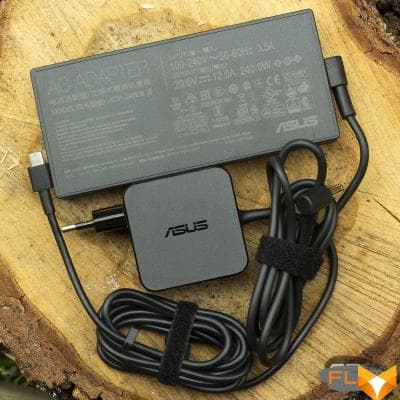 | 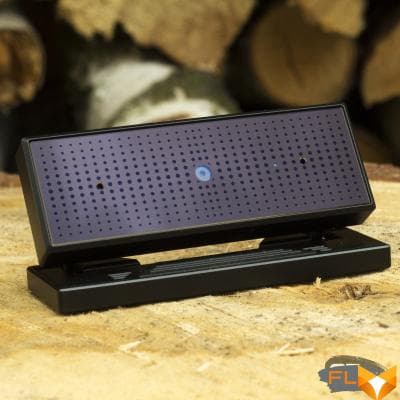 |
A lot of interesting things were found with the laptop. So, the computer is equipped with two external power supplies with a capacity of 240 and 65 watts at once. The compact power source is equipped with a USB Type-C connector – accordingly, the laptop supports USB Power Delivery 3.0 technology. It also comes with a ROG GC21 webcam with a mounting mechanism and a rubber wrist rest – a very useful thing for laptops with a keyboard located closer to the front edge of the case. The ROG Zephyrus Duo 15 external webcam supports Full HD resolution at 60Hz vertical refresh rate. Against the background of frankly poor 720p cameras installed in 99.9% of gaming laptops, ROG GC21 works just fine.
⇡#Appearance and Input Devices
When closed, the ROG Zephyrus Duo 15 is unremarkable. No, do not think anything bad: the laptop looks strictly and is built with high quality. The body of the device is entirely made of metal – I put it on a magnesium-aluminum alloy coated with a high degree of roughness. It’s just that when closed, the laptop is very reminiscent of other Zephyrs – in many respects just due to strict, well-defined forms. And we have tested a lot of such models lately.
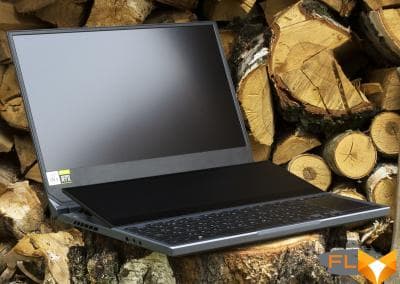 | 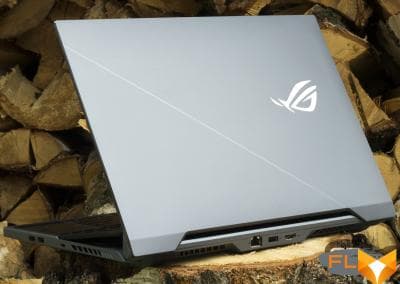 |
But everything changes, one has only to open the lid of the laptop! To do this, by the way, is very easy with one hand. An additional ROG ScreenPad Plus display appears, and a special hinge opens the laptop up to 13 degrees. Indeed, when working with the ZenBook Pro Duo UX581GV, the user looked at the second screen from a large angle – especially if the device was placed as far away from itself as possible. I had to get used to this situation, I noted this point in the review. Increasing the tilt of the ROG ScreenPad Plus corrects the situation somewhat – it really becomes more comfortable to use it.
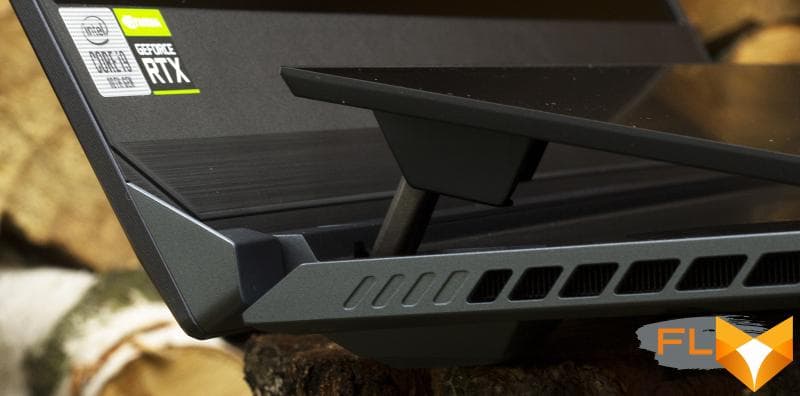
I think you understand perfectly well that in a short period of time it is impossible to form a clear and unambiguous opinion regarding the durability of the hinges used in the Zephyr. We will believe that there will be no problems with the ROG ScreenPad Plus, because this is still the main feature of a very expensive, elite laptop – the face of the company and the entire series of ROG gaming laptops to some extent.
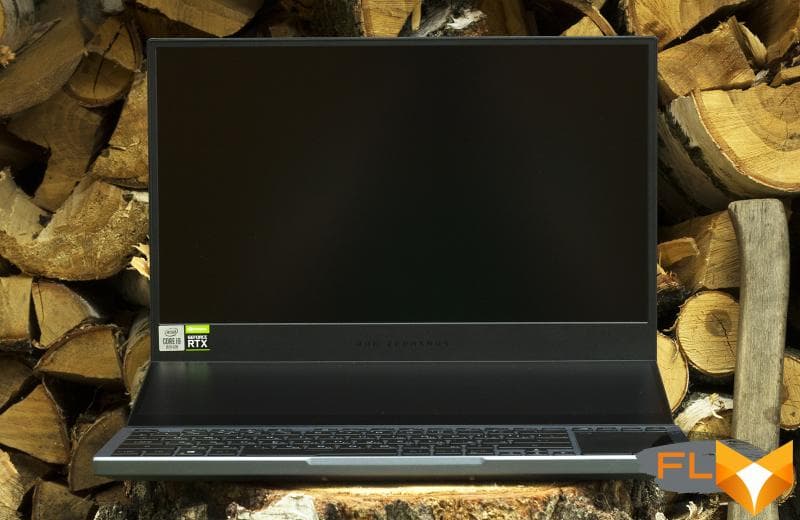
Let’s take a closer look at the additional screen. As I said, with a diagonal of 14 inches, ROG ScreenPad Plus has a resolution of 3840 × 1100 pixels, that is, its aspect ratio is 14:4. The display is touch sensitive and has an anti-reflective coating. For a 15-inch laptop, it looks quite large. By default, both screens work in extended mode – this already seriously increases the functionality of the system for those users who are used to using multiple monitors at once (I am one of them). At the same time, the additional display has its own menu, very reminiscent of the Start menu of the Windows operating system. Here we can change the settings of the ROG ScreenPad Plus, as well as launch applications that are loaded in the My ASUS program. By default, the laptop comes pre-installed with several programs such as Quick Key and Armory Crate. The first provides access to commonly used keyboard shortcuts, including your own. The second gives a report on the characteristics of the system and allows you to switch between laptop operating modes.
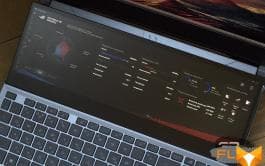 |  | 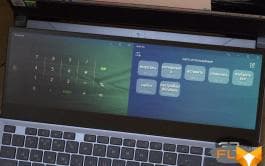 |
The screenpad menu allows you to manipulate the displays in different ways. So, there is a Task Swap function – when you press a key, the windows open on different screens are swapped. There is an option ViewMax – when it is enabled, for example, the browser is stretched to both panels. There is a Task Group mini-program: we click on the icon – and the laptop launches several applications at once, the list of which we configure ourselves. The Organizer menu allows you to arrange windows symmetrically on the secondary display. Finally, the App Navigator option shows all the programs running on the laptop as a ribbon.
In general, the functionality of ROG ScreenPad Plus is the case when it is better to see once than read a hundred times:
The raised display serves another function – it opens access to the laptop cooler vents. Through them, a pair of fans suck in air, which then exits from the perforated holes on the back and sides of the case. According to the manufacturer, this design move increased airflow by 30%.

You need to understand that the hinges of the ROG ScreenPad Plus are rigid, and the display will always rise when you open the laptop. In general, the design looks reliable, but it is better not to press hard on the center of the screen, it still bends.
Finally, I note that such a design did not force the engineers to drastically increase the thickness of the Zephyr’s case – it is a magnificent 20 mm. The laptop weighs 2.4 kg – and this, in principle, is a standard indicator for gaming “fifteen”.



ROG Zephyrus Duo 15 connectors are located in three places. The least used – HDMI output, RJ-45 and USB 3.2 Gen1 A-type – are hidden at the back. On the left side, there was only a port for connecting an external power supply and a pair of 3.5 mm mini-jacks. On the right side, there are two full-sized USB 3.2 Gen1 and Gen2, as well as USB 3.2 Gen2 C-type, combined with DisplayPort 1.4, Thunderbolt 3 and supporting the Power Delivery standard – it is to it that a compact 65 W external power supply is connected. In this mode of operation, the laptop battery is charged, but the computer cannot work at maximum load.
There is no card reader, but in the direction of the ROG Zephyrus Duo 15, professional photographers and people working with video content will probably look.
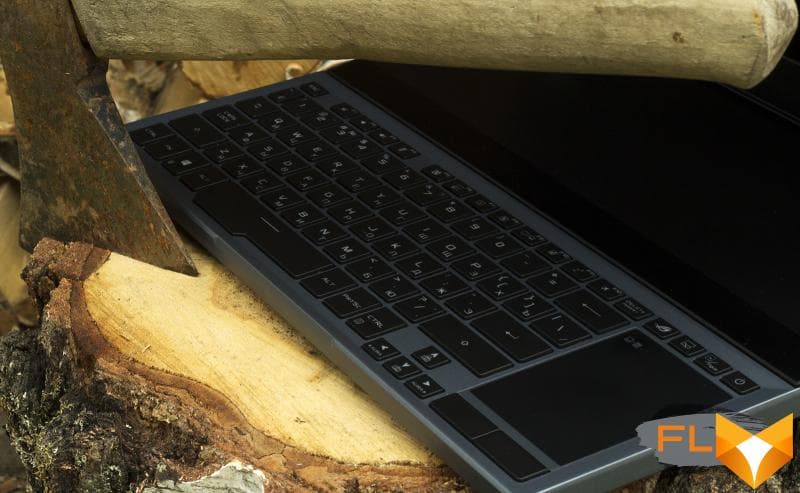
I have already told about the most unusual characteristic of the laptop keyboard – it is located as close as possible to the front edge of the case. Personally, it is convenient for me to use it if I move the device away from me by 10-15 cm. The wrist rest will not be superfluous – it has been checked. The dimensions of the laptop did not allow adding a number pad here, but it is integrated into the touchpad in the form of a touch area activated by a separate key. Due to the peculiarities of the keyboard layout, it will take some time to get used to working with the Zephyr. Especially if you are left-handed, because the touchpad is on the right, not in the center. On the other hand, a gamer will probably use a computer mouse almost all the time, and then the touchpad will not get in the way at hand.
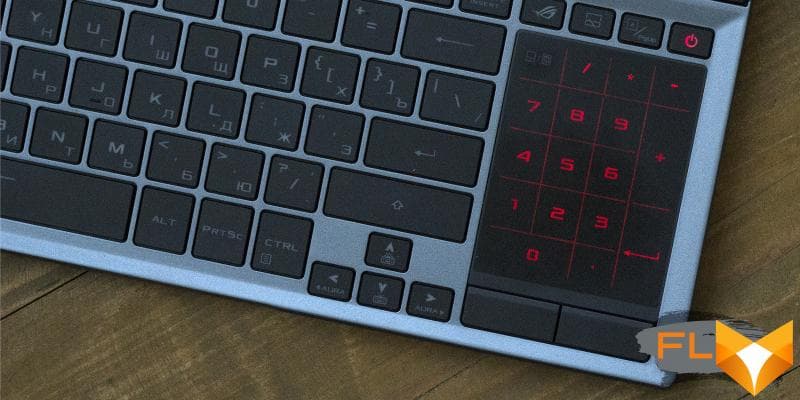
The touchpad supports Windows multi-touch gestures and handwriting, as is now customary. The buttons are pressed very easily, but there is a slight backlash.
The key travel is small and almost silent, their design uses a scissor mechanism. The keyboard is equipped with an independent RGB backlight for each button with three levels of brightness. True, Russian letters at any level look faded.
⇡#Internal design and upgrade options
The laptop is quite easy to disassemble: to get to the removable components of the computer, you need to unscrew 15 Torx screws.

The heat from the central and graphics processors is removed by a single cooling system, consisting of two tangential-type fans, five copper heat pipes and four rather large radiators. Each such section consists of copper ribs with a thickness of only 0.15 mm, and their total number was 252 jokes. In the ROG Zephyrus S, for example, the cooler heatsinks are assembled from 250 0.1mm copper fins.
The most interesting thing is that now ROG series laptops using 10th generation Core chips use Thermal Grizzly liquid metal – it is used only for cooling the CPU. According to ASUS, the new thermal interface reduces the temperature of the crystal by 14 degrees Celsius, and we will definitely check it out. The manufacturer also claims that special equipment is used for the correct application of ZhM, which eliminates the possibility of error. Thanks to a specially designed heat sink, the flow of liquid metal over time is impossible.
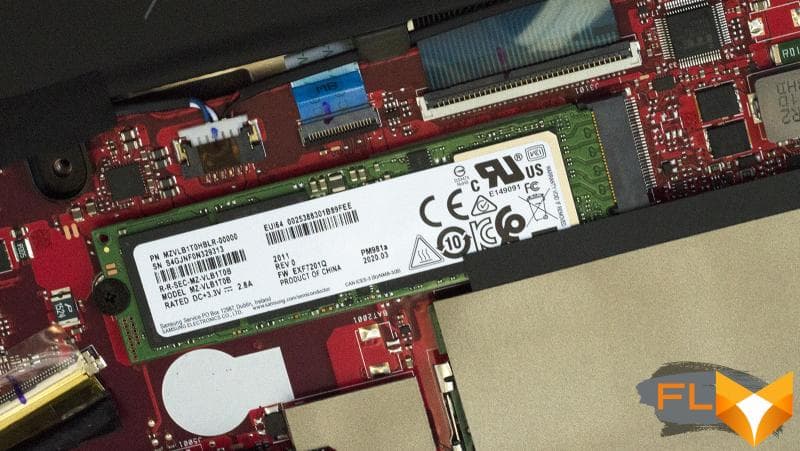
Sixteen gigabytes of RAM is already soldered on the laptop motherboard. On sale you will find versions with 32 GB of RAM – this means that an additional 16 GB DDR4-3200 card is inserted into the single SO-DIMM slot, but you can also install a 32 GB module yourself. In our case, we used a set from Samsung, marking M471A2K43DB1-CWE.
As for storage devices, two Samsung MZVLB1T0HBLR M.2 drives with a capacity of 1 TB each are installed on the motherboard at once. In general, there is no need to disassemble and upgrade the test version of the ROG Zephyrus Duo 15.
⇡#Test Methodology
The updated testing methodology for gaming laptops puts even more emphasis on PC gaming. Laptop performance was measured using various software.
Games (Full HD resolution):
- Counter Strike: Global Offensive. DirectX 9. Map Benchmark. Maximum quality, MSAA 8x + FXAA.
- World of Tanks enCore. DirectX 11. Benchmark. Ultra mode, TSSAA HQ.
- Dota 2. DirectX 11. Match recording. Maximum quality.
- The Witcher III: Wild Hunt. DirectX 11. Novigrad and surroundings. Maximum quality.
- GTA V. DirectX 11. Built-in benchmark (last scene). Maximum quality, FXAA + 2x MSAA, advanced quality settings on, 16x AF, image resolution scaling off
- The Elder Scrolls V: Skyrim Special Edition. DirectX 11. Riverwood and surroundings. Maximum quality, TAA. No mods.
- Total War Three Kingdoms. DirectX 11. Built-in benchmark. Max mode, TAA.
- Far Cry New Dawn. DirectX 11. Built-in benchmark. Maximum quality, HD textures – on, TAA.
- Assassin’s Creed Odyssey. DirectX 11. Built-in benchmark. Highest mode.
- Metro: Exodus. DirectX 12. Built-in benchmark. Ultra Mode
- Battlefield V. DirectX 12. The Last Tiger mission. Ultra Mode, TAA, DXR Off
- Shadow of the Tomb Raider. DirectX 12. Built-in benchmark. Maximum quality, DXR – off, TAA.
- Deus Ex: Mankind Divided. DirectX 12. Built-in benchmark. Maximum quality, 2x MSSA.
- Gears 5. DirectX 12. Built-in benchmark. Ultra Mode
- Red Dead Redemption 2. Vulkan. Built-in benchmark (last scene). Maximum quality (advanced settings – off), TAA.
- DOOM Eternal. Vulcan. Beginning of the game. Ultra Mode
Gaming performance was measured using the well-known MSI Afterburner program. It allows you to get the rendering time of each frame. The use of the 99th percentile instead of the minimum frames per second is due to the desire to clean up the results from random bursts of performance that were provoked by reasons not directly related to the operation of the main components of the platform.
Testing the laptop in games was carried out with the activation of the fastest mode suitable for these tasks.
Applications:
- Corona 1.3. Testing rendering speed using the renderer of the same name. Measures the build speed of the standard BTR scene used to measure performance.
- Blender 2.83. Determination of the final rendering speed in one of the popular free packages for creating three-dimensional graphics. The duration of building the final model pavillon_barcelona_v1.2 from Blender Benchmark is measured.
- x265 HD Benchmark. Testing the speed of video transcoding to H.265/HEVC format. The tables and graphs show the average integer value obtained after five runs of the test.
- CINEBENCH R20. Performance measurement of photorealistic 3D rendering in CINEMA 4D animation package, CPU test. The tables and graphs show the average integer value obtained after five runs of the test.
- Adobe Premiere Pro 2020 – Rendering a project in 4K resolution.
- Topaz Video Enhance AI v1.2.3. Performance testing in an AI-based program to improve video detail. The test uses the original video at 1280 × 720 resolution, which is scaled up by 150% using the Artemis-HQ model: P, HQ, MC.
Comprehensive benchmarks:
- Futuremark PCMARK10 Professional Edition 2.1.2177. Testing in Essentials scenarios (typical work of an average user: launching applications, surfing the Internet, video conferencing), Productivity (office work with a text editor and spreadsheets), Digital Content Creation (creation of digital content: photo editing, non-linear video editing, rendering and 3D visualization -models).
- 3DMark Professional Edition 2.11.6846. Testing in Time Spy and Fire Strike scenes.
- Unigine Superposition Benchmark. 1080p Extreme testing.
Notebook testing in resource-intensive applications was carried out in the default mode without any adjustment of the parameters of the central processor and cooler.
Display testing is performed using the X-Rite i1Display Pro colorimeter and the HCFR application.
The battery life of the laptop was tested in two modes. The first load option – web surfing – involves alternately opening and closing the tabs of the Computeruniverse.ru and Unsplash.com sites with an interval of 30 seconds. For this test, the current version of the Google Chrome browser at the time of testing is used. In the second mode, video in .mkv format and Full HD resolution is played in the built-in player of Windows OS with the repeat function activated. In all cases, the same display brightness was set to 200 cd / m2, and the keyboard backlight (if any) and the sound were turned off. When playing video, the laptop worked in airplane mode.
In games and other applications, the results of the following laptops are considered:
| Test participants | ||||||
| Model | Screen | Processor | RAM | Graphics | Drive | Battery |
| HP OMEN X 2S (15-dg0004ur) | 15.6”, 3840 × 2160, IPS | Intel Core i9-9880H, 8/16 cores/threads, 2.3 (4.8) GHz, 45W | 32 GB DDR4-3200 Dual Channel | NVIDIA GeForce RTX 2080 Max-Q 8GB GDDR6 | SSD, 2TB | 72 Wh |
| Lenovo Legion 7 | 15.6”, 1920 × 1080, IPS | Intel Core i9-10980HK, 8/16 cores/threads, 2.4 (5.3) GHz, 45W | 32 GB DDR4-3200 Dual Channel | NVIDIA GeForce RTX 2080 SUPER Max-Q 8GB GDDR6 | SSD, 2TB | 80 Wh |
| ASUS ROG Zephyrus Duo 15 | 15.6”, 3840 × 2160, IPS | Intel Core i9-10980HK, 8/16 cores/threads, 2.4 (5.3) GHz, 45W | 32 GB DDR4-3200 Dual Channel | NVIDIA GeForce RTX 2080 SUPER Max-Q 8GB GDDR6 | SSD, 2TB | 90 Wh |
⇡#Display and sound
Various modifications of the ROG Zephyrus Duo 15 are equipped with two types of main displays (the secondary screen is the same everywhere). It can be a Full HD matrix, but with a refresh rate of 300 Hz and a response of 3 ms. Or an IPS-matrix with a refresh rate of 60 Hz, but supporting the AdobeRGB standard. Apparently, this is how the manufacturer decided to attract both gamers and those who create content, and not just consume it. If I had a choice, then without hesitation I chose a faster standard definition matrix. However, the Zephyr test version uses the B156ZAN03.1 display from AU Optronics. The screen is good, but not ideal for professional work with photo and video content.
| Gamma | Gamut | Color temperature |
The maximum luminance of the white main display is 370 cd/m2, which is more than enough, even if you want to work outdoors in bright sunny weather or sit in a spacious office in front of a huge window. The minimum brightness is 18 cd/m2. B156ZAN03.1 has a good contrast ratio – 1352:1, the image will be deep, rich, lively, bright and fascinating. Therefore, this version of the ROG Zephyrus Duo 15 can be recommended to those who watch a lot of movies.
But the matrix calibration was carried out at an average level. The color temperature consistently stays above the standard 6500K, although grayscale stability is quite high. Gamma – 2.17 – is slightly below the reference value of 2.2. The average deviation of DeltaE on the gray scale is 4.12, and the maximum is 7.04. The average error in the ColorChecker24 test was 4.52 with a maximum error of 8.18. The color gamut exceeds the sRGB standard – the area of the triangle is 97% of the AdobeRGB gamut.
The declared viewing angles – 178 degrees in both planes – correspond to reality, there are no noticeable distortions to the eye. I did not find any visible light at the edges of the screen. Finally, the matrix used can be classified as a Flicker-Free solution in the entire working range of brightness.
| Gamma | Gamut | Color temperature |
The second screen is labeled BOE085F – the ZenBook Pro Duo UX581GV uses exactly the same IPS matrix equipped with a touch anti-glare coating. It has a contrast ratio of 1958:1 and a maximum brightness of 280 cd/m2. The minimum white luminosity level reaches 10 cd/m2. The color temperature of the ROG ScreenPad Plus stays mostly just below the standard 6500K – grayscale stability is at a good level. The gamma is unusually high – 2.99, although the matte finish of the screen may have affected the measurements. The average deviation on the gray scale reaches 2.02, and the maximum – 2.85. The average error in the ColorChecker test is 7.55 and the maximum error is 11.25. The color gamut falls short of 100% sRGB.
The sound quality of the pair of built-in 4-watt speakers in the ROG Zephyrus Duo 15 is simply excellent (adjusted for the fact that we are dealing with a laptop): there is bass, there is mids, there are tops. At the same time, the speakers have an excellent margin of volume. It is not necessary to buy an external speaker or headphones for a laptop.
⇡#Efficiency of the cooling system
As always, ASUS ROG laptops have several profiles that are responsible not only for the operation of the cooler, but also for the frequencies of the chips. In the review, as usual, I analyze the presets that provide high laptop performance. On the ROG Zephyrus Duo 15, these modes are Efficiency and Turbo.
Let’s start with the most important thing – games.
| Summary of laptop operation and setup | ||
| Laptop mode | “Efficiency” | “Turbo” |
| Declared GPU frequency (Boost) and memory speed | 1080 MHz, 11 Gbps | 1180 MHz, 11.24 Gbps |
| The Witcher III Real GPU Clock: Min, Max, Average | 1320 MHz | 1545 MHz |
| 1830 MHz | 1830 MHz | |
| 1364 MHz | 1583 MHz | |
| Maximum noise level | 41 dBA | 43.6 dBA |
| Average Power: GPU, CPU | 79.7W | 96.3W |
| 36.4W | 28.4W | |
| GPU Temperature: Average, Maximum | 71°C | 71°C |
| 73°C | 72°C | |
| CPU Temperature: Average, Maximum | 76°C | 73°C |
| 90°C | 84°C | |
| Performance, points | ||
| 3DMark Time Spy test results | 7551 | 8632 |
| 3DMark Fire Strike test results | 17327 | 19239 |
| Test results in Unigine Superposition (1080p Extreme) | 4720 | 5595 |
| Performance gain in benchmarks | +14%, +11%, +19% | |
| Rated operating mode | Turbo mode activation |
 |  | |
The difference between the modes is visible to the naked eye. Turning on the “Turbo” preset noticeably increases the frequency of the GPU, and also slightly overclocks the VRAM. If we compare the averages, we will see that the core frequency of the GeForce RTX 2080 SUPER increases by 200+ MHz. Such overclocking is achieved, however, by redistributing energy between the central processor and the graphics chip. If in the “Efficiency” mode the average frequency of all cores of the Core i9-10980HK is 3.8 GHz, then in the “Turbo” mode it is already 3.2 GHz. In most cases, this approach gives an impressive performance boost in games, however, as we know, there are processor-intensive applications in which the CPU also plays an important role. That is why in Unigine Superposition the inclusion of Turbo mode accelerated the system by 19%, and in 3DMark Fire Strike – only by 10%.
It’s nice that in both cases, the cooling system does its job completely – none of the components of the laptop overheat. For the “Core i9-10980HK + GeForce RTX 2080 SUPER Max-Q” bundle, the averages of 71 and 76 degrees Celsius for the GPU and CPU can be safely considered excellent. Moreover, such performance indicators are given to the owner of the ROG Zephyrus Duo 15 with little blood. The laptop is noisy, it cannot be called quiet, but you cannot call this model loud either – the operation of the laptop is not accompanied by an uncomfortable roar of fans.
| Laptop cooling performance in Adobe Premiere Pro 2020 | ||||
| “Efficiency” | “Turbo” | Turbo + Intel XTU | ||
| CPU frequency | Medium | 3.76 GHz | 4.06 GHz | 4.2 GHz |
| CPU temperature | Maximum | 97 °C | 97 °C | 98 °C |
| Medium | 79 °C | 91 °C | 91 °C | |
| Noise level | Maximum | 41.1 dBA | 43.1 dBA | 43.1 dBA |
| CPU power consumption | Average | 70.3W | 91.5W | 91.5W |
| Time to complete test task (less is better) | 825 s | 786 s | 773 s | |
| “Efficiency” | “Turbo” | “Turbo” + XTU |
It seemed that the release of 8-core processors from AMD and Intel could confuse laptop manufacturers, because in such cramped conditions it is quite difficult to effectively cool the advanced chips of both companies, and especially the “stones” of the Core family. But no, we see that some firms come out of this situation with honor. Lenovo has used an ultra-efficient vapor chamber in its Legion 7i, while ASUS and HP have switched to using liquid metal. And it does work! Look, the manufacturer did not hesitate to set the PL1 value to 70 and 90 W for the “Efficiency” and “Turbo” modes, respectively. As a result, in heavy resource-intensive applications, the frequency of all eight cores of the Core i9-10980HK keeps a very high mark. And if you use the Intel XTU program to further reduce the processor voltage, you will be able to squeeze almost the entire maximum out of the flagship Comet Lake, laid down by Turbo Boost technology, because on paper, when all eight cores are loaded, their frequency reaches 4.4 GHz.
Core i9-10980HK, as you know, has an unlocked multiplier, but we see that there is no point in overclocking this chip, the power limit can only be controlled within a short period of time, and with PL1 equal to 90 W, temperatures are already approaching the maximum allowable threshold . Obviously, in the test version of Zephyr, the Core i9-10980HK plays the role of a fashion component. In my opinion, you can safely save money and take a model with Core i7-10875H, the difference in performance will be minimal.
⇡#Laptop performance
ROG Zephyrus Duo 15 uses the mobile version of the GeForce RTX 2080 SUPER – the fastest laptop gaming graphics to date. Yes, in our case we are talking about the Max-Q design, but earlier we found out that in the “Turbo” mode, the laptop’s graphics operate at higher frequencies of the chip and memory.
And to be honest, I have nothing more to add to what was said earlier. The table below clearly shows that such a GeForce RTX 2080 SUPER is enough to play almost any modern game in Full HD resolution at the maximum graphics quality settings. To achieve higher FPS, you will have to delve into the application settings: somewhere it is better to disable shadows, somewhere it will be more effective to reduce the quality of textures – getting a noticeably higher FPS in the case of the GeForce RTX 2080 SUPER will not be a problem, in general.
And yes, Zephyr was not tested in Ultra HD resolution – I don’t see the point in this, since with a diagonal of 15.6 inches it plays well in Full HD. I have already expressed my preferences for the screen for this laptop.
Interestingly, in Turbo mode, the ROG Zephyrus Duo 15 outperforms the recently tested HP OMEN X 2S by 10% in the Time Spy benchmark and 20% in the Unigine Superposition.
| Test results in games, Full HD, FPS | ||
| AVG | 1% MIN | |
| Multiplayer Games | ||
| World of Tanks enCore | 181 | 125 |
| Dota 2 | 145 | 86 |
| Counter Strike: Global Offensive | 324 | 91 |
| Old but still popular games | ||
| The Witcher III: Wild Hunt | 107 | 67 |
| GTA V | 81 | 53 |
| The Elder Scrolls V: Skyrim Special Edition | 145 | 107 |
| Deus Ex: Mankind Divided | 61 | 40 |
| (Relatively) modern games | ||
| Assassin’s Creed Odyssey | 62 | 51 |
| Far Cry New Dawn | 94 | 66 |
| Total War Three Kingdoms | 71 | 55 |
| Red Dead Redemption 2 | 61 | 48 |
| Battlefield V | 107 | 64 |
| Metro: Exodus | 61 | 30 |
| Shadow of the Tomb Raider | 87 | 67 |
| Gears 5 | 91 | 62 |
| DOOM Eternal | 199 | 146 |
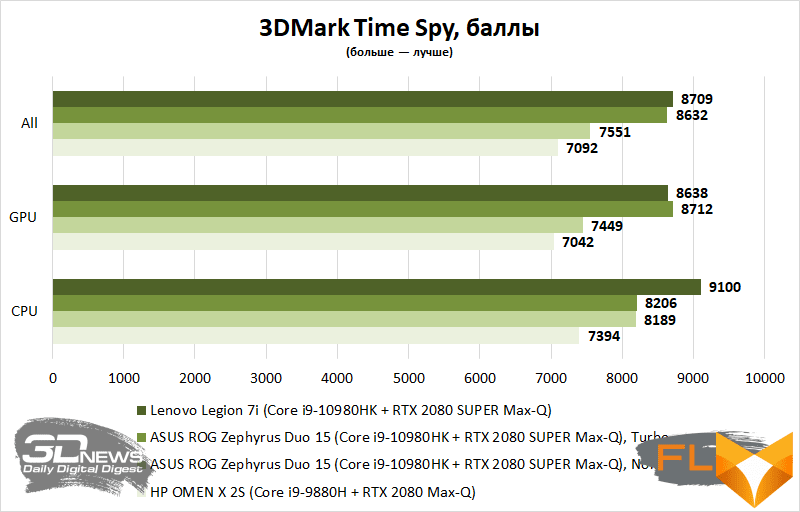
We have slightly updated the testing methodology, so the database of laptop results in some applications and benchmarks is only filling up. So, now we are not only testing the processor-memory link, but also studying the possibilities of graphics processing power.






Below are the results of testing the laptop in the PCMARK10 comprehensive benchmark.
In a number of tests (archiving, working with graphics and photo and video content, interaction with browsers, as well as office applications), the laptop drive plays an important role. The ROG Zephyrus Duo 15 has two terabyte SSDs at once, combined into a RAID 0 array. The Samsung MZVLB1T0HBLR model belongs to the PM981a series, and this, as you know, is an OEM version of the notorious 970 EVO Plus model. Well, before you is one of the fastest M.2 drives of our time.
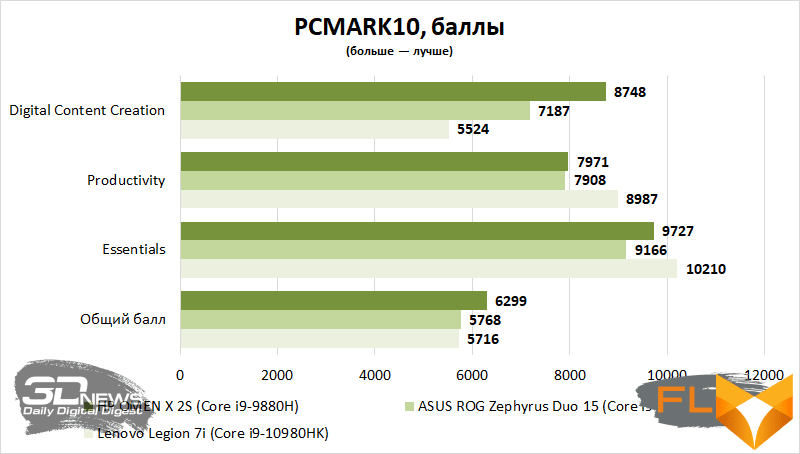
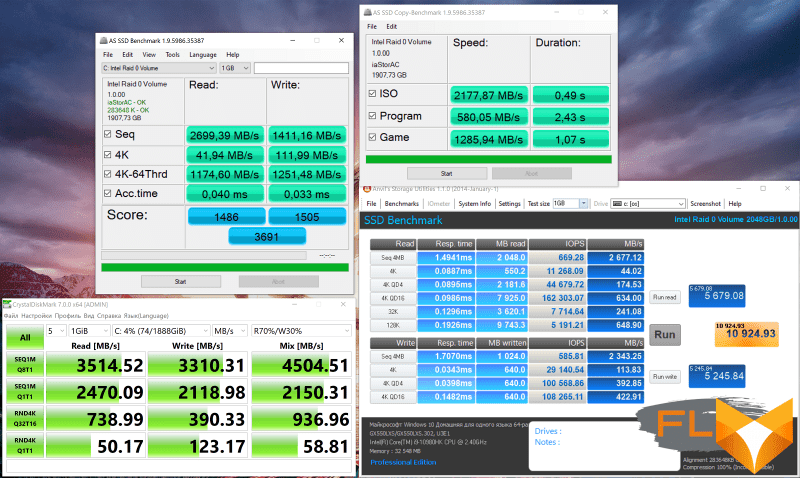
⇡#Laptop Offline
The laptop comes with a 90 Wh lithium-ion battery. The battery is capacious, but the laptop uses powerful components (8-core processor, the fastest graphics, two SSDs, a heaped Wi-Fi module, two displays), so even without tests it is obvious that the ROG Zephyrus Duo 15 is not able to work for a long time from one charge. For greater clarity, I tested the laptop in two modes at once: with ROG ScreenPad Plus on and off.
The battery is fully charged from a 240-watt PSU in an hour and a half.
| Battery life | ||
| Main screen – on, 200 cd/m2 Extra screen – on, 200 cd/m2 | Main screen – on, 200 cd/m2 Sub screen – off | |
| Web | 3 h 17 min | 4 h 4 min |
| View video | 4 h 46 min | 5 h 44 min |
⇡#Conclusions
I hope my short story was enough for you to form your own opinion on whether ROG ScreenPad Plus is needed in a gaming laptop. Something tells me that there will not be an unambiguous opinion here – and this is normal. At the same time, the additional display in the ROG Zephyrus Duo 15 really looks like a “killer feature” – a feature that attracts the attention of others. The way HP engineers implemented this idea in their OMEN X 2S personally raises a lot more questions for me, one of which sounds like this: why is such a “stub” needed at all? Here (after all, everything is known in comparison) we get a full-fledged display with all the resulting functionality.
I was blown away by how easily the ROG Zephyrus Duo 15 cooler handles very, very hot chips. New heatsinks, liquid metal, and more efficient airflow have tamed the rather hot temper of the 8-core Core. And the cooling system is not so loud. Of course, the new “Zefir” is one of the most productive laptops that have been with us lately.
Perhaps, in the near future, laptops with two screens will become commonplace, but so far the price for them is cosmic.


